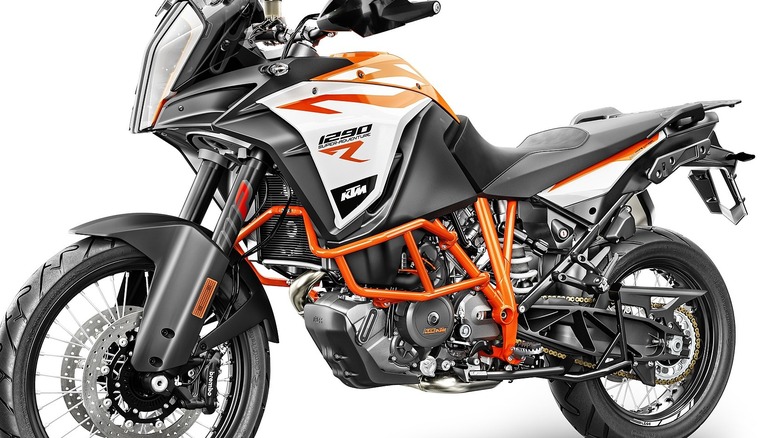What Are Motorcycle Crash Bars And Are They Worth Installing?
Let's be honest, there's nothing that can top the feeling of flying down a highway with your hand on the throttle of a motorcycle and the sun on your face. The feeling of driving a motorcycle is the closest you get to freedom on the open road, which also means that there is literally nothing between you and the open road. As exhilarating as it would have been to take Hagrid's flying motorcycle out for a spin, even that magically fused bucket of bolts experienced quite the horrendous crash at the end. Because motorcycles are inherently lightweight to maximize speed and maneuverability, they are equipped with basic safety features that do little to reduce a driver's exposure to potential hazards. So what additional mechanisms are utilized to protect both the driver and the body of the motorcycle itself?
Motorcycle crash bars are configured to safeguard the gasoline tank, engine, and other critical parts from impacts during an accident. Also known as engine guards, these metal bars are formed to fit the shape of the motorcycle's body while functioning as reinforcement to its components and a shield to the driver's lower body. Depending on the quality and whether additional accessories are included, the price of crash bars can range from $80 to as high as $352. Yet when it comes to effectiveness during accidents, the average performance of crash bars tends to vary depending on the magnitude of the accident.
[Featured image by KTM AG via Wikimedia Commons | Cropped and scaled | CC BY-SA 4.0]
Crash guards are useful at protecting against low-impact accidents
Crash guards are designed first and foremost to distribute impact force on the motorcycles critical components. This helps to not only reduce repair costs but also prevent other consequential incidents like the motorcycle spontaneously combusting due to a perforated gasoline tank. Crash guards also provide protection for the driver against any potential lower leg trauma. In a study published by the National Library of Medicine 8 out of the 25 motorcyclists (32%) that were using crash bars when they experienced a side-impact traffic accident walked away with minimal, if any, injuries to the lower extremities. Due to its design and durability, crash bars serve as a barrier that not only insulates the legs on impact but also deters sliding on the pavement. However, its effectiveness appears restricted to low-impact or tip-over incidents. As the severity of the accident escalates, it becomes more likely that the guard will fail or fracture, potentially worsening any damage to both bike and driver.
The materials and design of the crash bars are key for maximum effectiveness
Overall, crash bars provide some degree of enhanced protection to both the driver and motorcycle itself, yet they are not a bullet-proof guarantee that both will emerge from all types of accidents free from injury. Depending on critical factors such as the raw base materials used to construct the crash bars and whether their design is a compatible fit they can be worth the additional costs in installation and maintenance. For example, due to its strength and pliability under high pressure, mild steel is considered the optimal metal for crash guards in comparison to other types like stainless or aluminum. When it comes to safety measures for motorcycles it is important to understand there is no one product that offers a complete and consistent remedy. Drivers have to remember that there are a variety of features to assess within the motorcycle itself as well when determining safety including the assembly and engineering of the individual components. Plus, you may want to consider picking up some other accessories necessary for a safer motorcycle ride.


